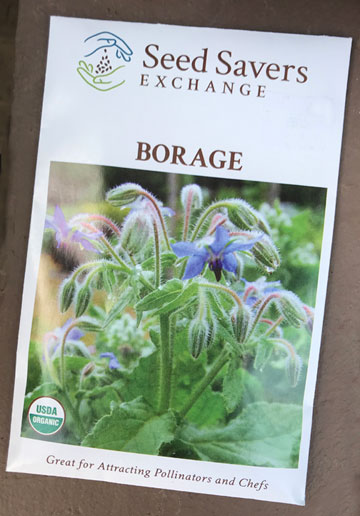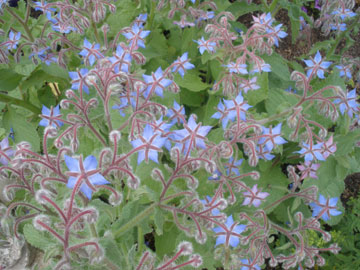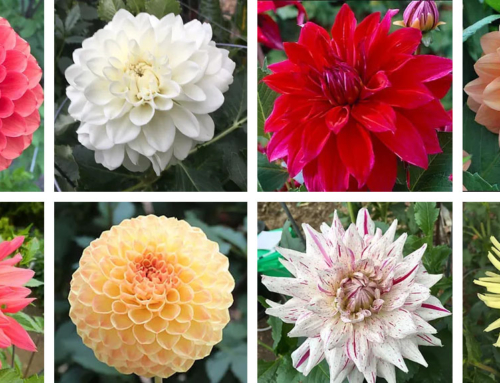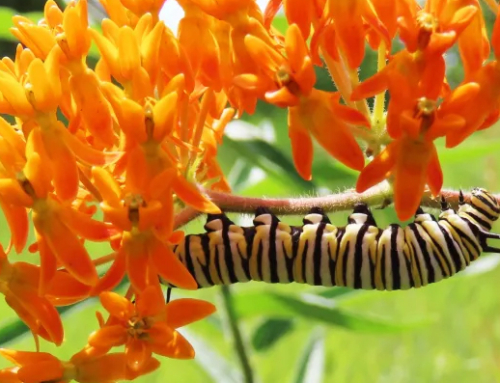 The first time I had ever seen Borage was on the grounds of the Seed Savers exchange in Decorah, Iowa. The historic barn caught my eye and nearby a sign that read, “Diane’s garden.” This lovely cottage garden was full of beautiful flowers and herbs of all sorts. Each plant was labeled and I jotted down several of my favorites. Near the rustic fence was a mass of blue flowered plants. I was enchanted with the color as well as the numbers of bees and butterflies that were nectaring there. I looked to see its name and wrote down “Borage.” The Latin name is Borago officinalis. It is also known as a starflower because the form of the flowers is like a star. Before I left the grounds that day, I purchased a packet of seeds.
The first time I had ever seen Borage was on the grounds of the Seed Savers exchange in Decorah, Iowa. The historic barn caught my eye and nearby a sign that read, “Diane’s garden.” This lovely cottage garden was full of beautiful flowers and herbs of all sorts. Each plant was labeled and I jotted down several of my favorites. Near the rustic fence was a mass of blue flowered plants. I was enchanted with the color as well as the numbers of bees and butterflies that were nectaring there. I looked to see its name and wrote down “Borage.” The Latin name is Borago officinalis. It is also known as a starflower because the form of the flowers is like a star. Before I left the grounds that day, I purchased a packet of seeds.
Since this is the time of year when we eagerly look through the seed catalogs for something fun to add to our gardens, consider this easy to grow herb. Seeds are available at most garden stores or you can order plants through the catalogs. You can start seeds indoors 6 to 8 weeks before the last spring frost or sow them directly into the garden. A fast growing annual herb, it blooms early summer into fall and readily self seeds, so once you plant it you won’t need to do so again. It prefers a sunny location but will also grow in partial shade. Height ranges from 2 to 3 feet and the stems and leaves are covered with prickly hairs.
 Borage is considered a beneficial companion plant. It produces pyrrolizidine alkaloids that act as a defense mechanism against insect herbivores, therefore improving pest and disease resistance of plants growing near it. The prolific flowers are a magnet for bees, so pollination of nearby vegetables and fruits will also be enhanced. It is beneficial to legumes, spinach, brassicas and even strawberries. The U of M is doing research involving borage and strawberries in particular: http://fruit.umn.edu/content/berries-bees-borage
Borage is considered a beneficial companion plant. It produces pyrrolizidine alkaloids that act as a defense mechanism against insect herbivores, therefore improving pest and disease resistance of plants growing near it. The prolific flowers are a magnet for bees, so pollination of nearby vegetables and fruits will also be enhanced. It is beneficial to legumes, spinach, brassicas and even strawberries. The U of M is doing research involving borage and strawberries in particular: http://fruit.umn.edu/content/berries-bees-borage
 There are many other reasons to love borage. It has a cucumber like flavor that enhances fish or chicken dishes. The leaves and stems can be chopped and added to salads, soups and stews. The leaves can be cooked like spinach, dipped into batter and fried, used to infuse vinegar, or even dried to make tea. The lovely blue flowers can be used for a fresh garnish, frozen into ice cubes for cold drinks, or crystallized for use in decorating cakes. Borage seed oil is used in skin care products and can be used in place of flaxseed oil or fish oil. Like many herbs numerous health and medicinal qualities are attributed to the borage plant. Of course, herbal remedies should only be used under an expert’s recommendation.
There are many other reasons to love borage. It has a cucumber like flavor that enhances fish or chicken dishes. The leaves and stems can be chopped and added to salads, soups and stews. The leaves can be cooked like spinach, dipped into batter and fried, used to infuse vinegar, or even dried to make tea. The lovely blue flowers can be used for a fresh garnish, frozen into ice cubes for cold drinks, or crystallized for use in decorating cakes. Borage seed oil is used in skin care products and can be used in place of flaxseed oil or fish oil. Like many herbs numerous health and medicinal qualities are attributed to the borage plant. Of course, herbal remedies should only be used under an expert’s recommendation.
Historical records of borage describe its ability to make men and women merry, to comfort the heart, dispel melancholy and offer courage. The Celtic name “borrach” means courage and it is known as an herb of gladness. When you are planning your spring garden, why not include a packet of borage. It will reward you with its beauty and provide a pollinator paradise.
By Val McGruder, Hennepin County Master Gardener
Feature photo by: Melinda Mattox, Hennepin County Master Gardener Volunteer




